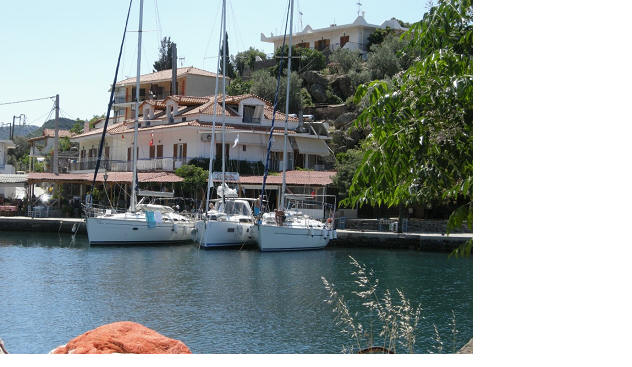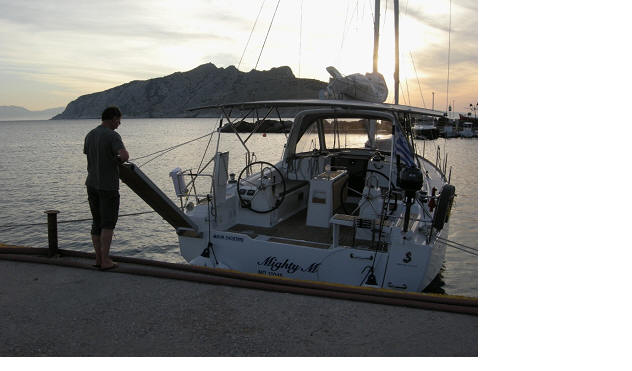|
|
South Yorkshire |
 |
| Use back button |
Can you moor Stern-To in the Med
Stern-to mooring on anchor is tricky. People watching,
crowded harbours, novice crews, all add up to put you off. A
few basic rules and a little advice will ease the tension
for the skipper and crew. If you are flotilla sailing then the permanent
leaders will sort you out. If you did the job well award
yourself the badge shown below.
Stern-to mooring using lazy lines can equally be tricky especially against an empty quay side and strong cross winds.


1. Especially in an unfamiliar place it makes obvious sense to conduct a 'reccy entry' to pinpoint, in order, the safest, easiest, most convenient spot. Remind the crew the procedures involved and agree the final plan.
2. Fenders should be arranged to the stern and also to sides as appropriate. Stern lines should be prepared for the stern crew or for the skipper to step off if short crewed. If there is any appreciable cross wind plan to secure the windward line first. Stern lines should be initially set at 2m and terminated in a bowline*. This enables rapid deployment and no complications especially if someone shore-side takes the lines. * if the xxx are rings then slip through and over.
3. The skipper should be on the helm and should request silence from the crew except in emergency. This will ensure a clear exchange by hand sign or voice to the bow anchor crew. Take the longest possible approach to the berth to exclude prop walk and to enable good directional control through rudder and keel flow.
4. Drop the anchor 3+ boat lengths from the quay. The choice depends on the conditions and the anchor scope, in a well-protected crowded harbour 2 is OK. If the quay is susceptible to an on-to shore swell or if the scope is a combination of chain and line then select 3+.
5. Drop the anchor directly in line with the position or gap you plan to fill. There are two reasons for this. Firstly is to avoid fouling mooring lines of adjacent boats. Secondly if you are not in line then squaring the boat at the quay side can be quite difficult. When you drop the anchor in line the boat
need not be pointing straight back into the selected spot and could be manoeuvring since the anchor position will be the final squaring factor when you tighten up.
When lazy lines are available there is no anchor chain to hold the bow in line and as you slow towards the quay, to pick up the lines, the bow may be blown over. This may be OK if the quay is busy and you are leaning on fenders but if the quay is empty you should approach with a compensating angle to allow for the swing as you pick up
the lines.
6. When the command for anchor release is given it should be continuously fed by the winch man and not selectively stopped except in emergency or by instruction. We must avoid the anchor taking hold and stopping the boat before the quay because steerage will be lost.
7. Steer back positively into the gap with a speed of the order ½ to 1 knot. You must ensure that the anchor chain or the anchor taking hold do not stop or control the boats approach. If you approach too slowly the anchor or the chain may stop you, to then be left wallowing with no steerage. Unless there are adjacent boats to grab you then have little choice but to restart the manoeuvre.

8. Approximately 1m from the quay sign or call for the winch man to stop and simultaneously cut the drive. The boat will stop almost immediately due to the chain weight and will be close enough to step off or allow the stern crew to step off and fix the shore lines, windward line priority. With lazy-lines come to a stop close enough for the line-man to step off safely. Pick up the line with the boat hook and wear gloves in anticipation of encrusted lines.
9. Draw forward on the anchor or lazy lines to square your position before back tightening the stern lines for appropriate quay side clearance, or where swell may become an issue.
10. Finally, should we accept advice from the quay side regarding our selected spot and approach; or an offer to handle our lines?
I think that could be the subject of another blog!